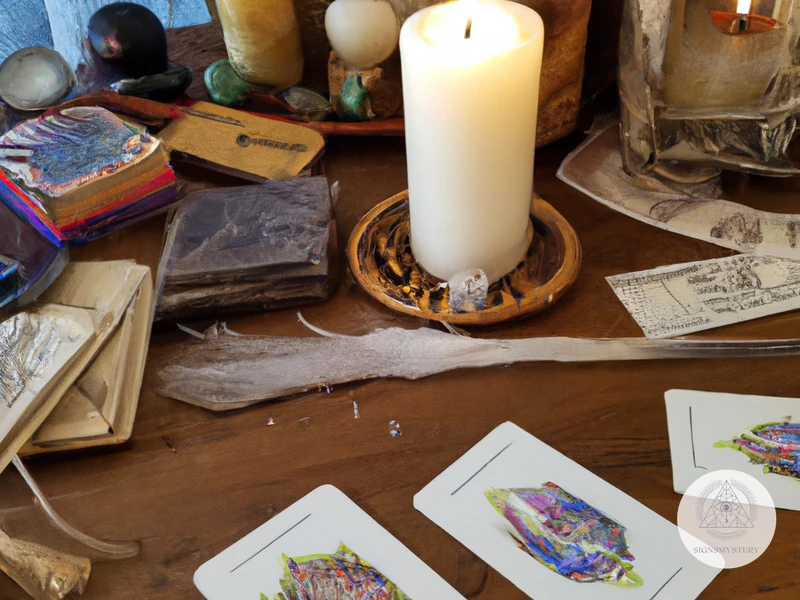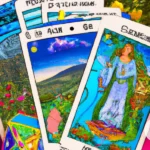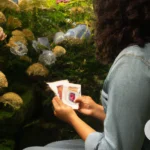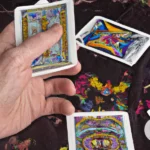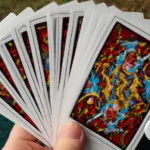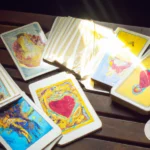Throughout history, people have turned to divination as a means of seeking guidance and understanding. One of the most popular forms of divination is the use of oracle cards. Oracle cards are a tool that enable individuals to access their intuition and connect with their higher selves for greater insights and wisdom. But where did oracle cards come from? How have they evolved over time? And what is their significance today? In this article, we will explore the fascinating history of oracle cards, from their early beginnings in ancient China to their modern-day use in mainstream culture. Join us on a journey through time and discover the evolution of these mystical and powerful tools.
Early Forms of Divination
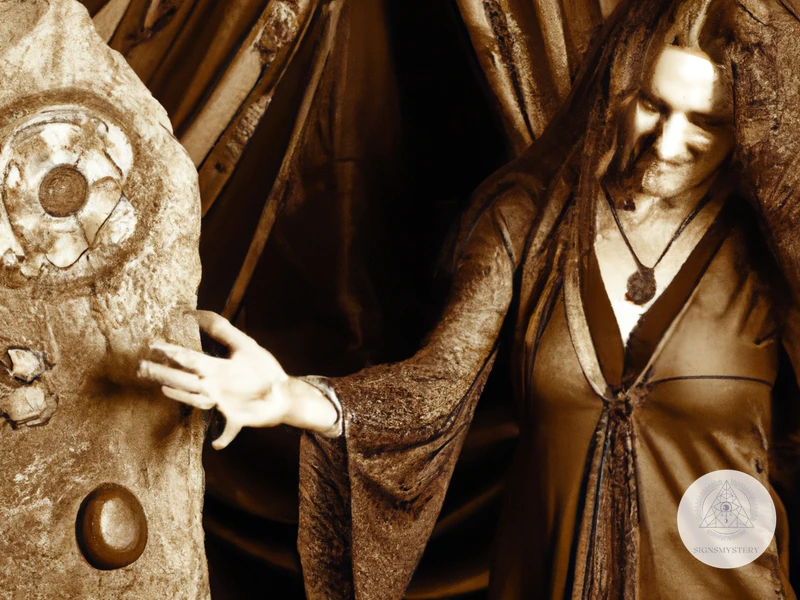
When exploring the history of divination, it becomes apparent that humans have always been intrigued by the idea of seeing into the future or gaining insight into the unknown. Different cultures throughout history have developed various methods of divination, ranging from interpreting the flight patterns of birds to deciphering dream meanings. One popular form of divination that emerged in different parts of the world were oracle cards. These cards came in many forms, each with a unique set of symbols and meanings. In this section, we will explore some of the early forms of divination that eventually led to the creation of oracle cards. We will delve into the Oracle Bones of China, the Tarot Cards of Europe, the Lenormand Cards of France, the Playing Cards of the Middle East, and the Mamluk Cards of Egypt.
The Oracle Bones of China
The practice of divination has a long and complex history, and one of the earliest known forms of divination is that which was practiced by the ancient Chinese through the use of oracle bones. These bones were typically the shoulder blades of oxen or the plastrons of turtles, and they were used to divine the future or to communicate with ancestors.
These bones were inscribed with questions or statements and heated until they cracked. The cracks would then be interpreted by a diviner to reveal the answer to the question or the message from the ancestor. It is believed that this practice dates back to the Shang dynasty, which lasted from the 16th to the 11th century BCE.
The inscriptions on the oracle bones provide valuable insight into the beliefs and practices of the Shang dynasty. They demonstrate that the Shang placed great importance on the spiritual realm, and they show that divination played a significant role in their lives. The diviners who practiced this form of divination were highly respected members of society, and they were consulted by the rulers of the Shang dynasty on matters of state.
The oracle bones may seem crude and unsophisticated by modern standards, but they represent an important milestone in the development of divination practices. They paved the way for other forms of divination, including the tarot cards of Europe and the Lenormand cards of France.
To read more about the history of tarot cards and their origin in Europe, check out Tarot Cards Origin: Europe. For information on famous tarot card decks and their creators, visit Famous Tarot Card Decks and Their Creators.
The Tarot Cards of Europe
Tarot cards are perhaps the most well-known divination cards in the world. Originating in Europe in the 15th century, these cards have had a long and fascinating history. The Tarot Cards of Europe consisted originally of a deck of playing cards with 21 trump cards that were used for card games. It wasn’t until later that they became synonymous with divination.
The first known tarot deck was created in Italy and was known as the Visconti-Sforza deck. This deck was created for the Duke of Milan and was hand-painted by Bonifacio Bembo. Over the next century, different versions of the tarot deck began to emerge, from the French tarot to the German tarot. However, it wasn’t until the 18th century that tarot cards gained prominence in the world of divination.
A Frenchman named Jean-Baptiste Alliette (also known as Etteilla) is credited with being one of the first people to use tarot cards for divination purposes. He published a book called Etteilla, ou l’art de lire dans les cartes, which translated means Etteilla, or the Art of Reading Cards. This book was the first to outline the use of tarot cards for divination and included a guide for interpreting the meanings of the cards.
The symbolism of tarot cards has been the subject of much study and interpretation over the years. Many people believe that the cards hold a certain power, which is why they are used for divination. The cards are often associated with the Hermetic philosophy, which is a set of philosophical and religious beliefs based on the writings of Hermes Trismegistus. The Hermetic philosophy emphasizes the idea of “as above, so below,” which means that the microcosm reflects the macrocosm and vice versa.
Today, tarot cards are still widely used for divination purposes and have become a part of mainstream pop culture. From the iconic Rider-Waite-Smith deck to the more modern decks that have emerged, tarot cards continue to fascinate and intrigue people around the world.
The Lenormand Cards of France
In France during the late 18th and early 19th centuries, a new form of divination using cards was emerging. Marie-Anne Adélaïde Lenormand, a well-known fortune-teller of the time, created a deck of cards that would eventually bear her name: the Lenormand Cards. These cards are still widely used today, known for their simplicity and versatility.
Design: The Lenormand Cards are a deck of 36 cards, each with a single image and a title. The cards are small and can easily fit in the palm of one’s hand. The designs are not as elaborate as the Tarot, but they are still rich with symbolism. The images on the cards depict everyday objects, such as a key or a tree, and have multiple interpretations depending on the context in which they appear in a reading.
Interpretation: Unlike the Tarot, which has a complex system of archetypes and meanings, the Lenormand Cards rely more on the intuition and creativity of the reader. Each card has a basic meaning, but the real magic comes from the way the cards interact with each other in a spread. The reader may use a simple three-card spread or a more elaborate Grand Tableau spread, which uses all 36 cards.
Legacy: Although the Lenormand Cards were not as popular as the Tarot in their time, they have had a lasting impact on the world of divination. In recent years, there has been a resurgence of interest in the Lenormand Cards, with new decks being created and new interpretations of the cards emerging. They have also been adapted to fit modern themes, such as the “Coffee Lenormand” or the “Fairy Tale Lenormand.”
This simplistic yet powerful tool of fortune-telling has become a staple in many diviners’ arsenals. Interested in the history of Tarot Cards as well? Check out our article on Tarot Cards of Medieval Europe.
The Playing Cards of the Middle East
Playing cards have known their use in the Middle East since the 13th century. As with other early forms of divination, the cards were not originally intended for use in fortune-telling but for playing games. However, over time, they began to be used for divinatory purposes as well.
Meaning: The cards were used for divination in a similar way to Tarot cards. Each card had a specific meaning and interpretation, and the cards were laid out in a particular pattern to give insight into a person’s life or future.
Significance: It is believed that these cards were brought to Europe by Gypsies and eventually evolved into the modern-day Tarot deck. The Middle Eastern playing cards are still used for divination in some areas today, particularly in the Middle East and Central Asia.
Link: To learn more about the symbolism of Tarot and other oracle decks, visit /symbolism-tarot-oracle/.
The Middle Eastern playing cards were an important precursor to modern oracle decks, particularly in their use of symbolism and divinatory practices. As with other early forms of divination, the use of playing cards for fortune-telling likely arose from a desire to understand the world and seek guidance in uncertain times. The history of oracle decks is a fascinating one, and reveals much about the human thirst for knowledge and understanding. To learn more about the broader history of oracle decks, see our article on the history of oracle decks.
The Mamluk Cards of Egypt
The Mamluk Cards were originally created in Egypt during the 15th century for the ruling class of the Mamluk Sultanate. They were not created for divination purposes, but rather as a simple deck of playing cards used for games such as Ganjifa and Triomphe.
However, the Mamluk Cards were unique in their design, featuring intricate and colorful geometric patterns. Each suit had ten pip cards and three court cards, with each court card portraying a different rank of social status in the Mamluk court. The suits were cups, swords, coins, and polo sticks.
Although not created for divination, it is believed that these cards may have influenced the development of tarot cards in Europe. The Mamluk Cards were introduced to Italy by traders and became highly sought after due to their exquisite design.
Fun fact: The Mamluk Cards are one of the earliest known playing card decks in existence, predating the popular tarot cards by several centuries.
It is interesting to note the similarities between the Mamluk Cards and the tarot cards, both featuring distinctive suits and court cards representing various social statuses. The connection between the two has been explored by scholars, with some theories suggesting that the Mamluk Cards may have been used for divination in secret.
The impact of the Mamluk Cards on the development of playing cards and divination decks cannot be overlooked. Without their influence, it is possible that tarot cards and other oracle decks may have looked vastly different than they do today.
The Mamluk Cards serve as an important piece of history in the evolution of playing cards and divination decks. Despite not originally being created for divination, their intricate design and cultural significance have left an enduring impact on the world of card reading and gaming.
The Birth of Modern Oracle Cards
As the practice of divination has evolved throughout history, so have the tools used for gaining insight and guidance. The birth of modern oracle cards is a pivotal moment in the timeline of divination, as it marks a time when traditional practices were being transformed and adapted for contemporary use. Several historical movements and influential figures played a significant role in the development of modern oracle cards. These include the works of Etteilla and Lenormand, the Spiritualist movement, the Golden Dawn and Aleister Crowley, the influence of Carl Jung, and the rise of New Age spirituality. Each of these elements contributed to the creation of divination tools that are still popular today.
The Spiritualist Movement of the 19th Century
During the late 19th century, spiritualism emerged as a popular movement, particularly in the United States and Europe. This was a time of great change and upheaval, with many people seeking solace and guidance from the spiritual realm.
One of the key practices of spiritualism was mediumship, or the ability to communicate with the dead. Mediums often used various forms of divination to facilitate these communications, including tarot cards, playing cards, and other types of oracle cards.
One of the most notable figures of the spiritualist movement was the medium and healer Madame Helena Blavatsky. Blavatsky was a pioneer of theosophy, a spiritual philosophy that sought to reconcile science and spirituality. She believed that divination tools such as tarot cards could be used as a way to communicate with higher spiritual beings and gain insight into the nature of reality.
Other spiritualist leaders, such as Andrew Jackson Davis and Emma Hardinge Britten, also advocated for the use of divination tools as a means of communicating with the spirit world. As a result, many new types of oracle cards were developed and used during this time.
It is worth noting that while spiritualism was a popular movement during this time, it was often viewed with skepticism and even outright hostility by many mainstream religious institutions. However, the use of divination tools such as oracle cards continued to grow in popularity throughout the 20th century and into the present day, as more and more people seek out spiritual guidance and connection to the divine.
Want to know more about the connection between tarot cards and spiritualism? Check out our article on Tarot and Hermetic Philosophy. And to learn more about the rise of oracle cards in modern spirituality, head over to our piece on the Rise of Oracle Cards in New Age culture.
The Works of Etteilla and Lenormand
During the 18th century, two influential figures emerged in the world of divination, laying the foundation for the modern oracle card decks we know today. These individuals were Etteilla and Lenormand, and their works had a tremendous impact on the development and evolution of oracle cards throughout history.
Etteilla was a French occultist who is credited with creating the first Egyptian tarot deck, which he called the “Book of Thoth.” He believed that tarot cards held ancient mystical knowledge that could be unlocked and used to tap into the divine. Etteilla also developed a system of cartomancy, which involved using playing cards for divination. His system was based on astrological correspondences and numerology, and he published several influential books on the subject.
Lenormand, on the other hand, was a French fortune teller who gained fame during the Napoleonic era for her accurate predictions. She was known for using a unique deck of cards that came to be known as the Lenormand deck. The Lenormand deck consisted of 36 cards, each with its own symbolic meaning. The deck was designed to be used for practical divination, rather than the esoteric and mystical purposes of the tarot.
The works of both Etteilla and Lenormand were highly influential in the development of modern oracle card decks. Many of the symbols and themes used in their decks have been carried forward to contemporary oracle cards, and their systems of cartomancy continue to be used by practitioners today.
It’s interesting to note that while both Etteilla and Lenormand were highly respected in their time, they were also seen as controversial figures. Some believed that their methods of divination were fraudulent, while others saw them as heretical or even dangerous. Nevertheless, their influence on the development of oracle cards cannot be denied, and their legacies continue to be felt in the world of divination and spirituality today.
In recent years, oracle cards have become more popular than ever, with many new decks being created and published each year. To learn more about the role of oracle cards in pop culture, check out our article on Tarot Cards in Pop Culture.
The Golden Dawn and Aleister Crowley
During the late 19th and early 20th centuries, the Golden Dawn, a secret society based in England, had a significant impact on the development of modern divination practices. One of its most prominent members was Aleister Crowley, a controversial figure known for his involvement in occultism and magick.
Crowley’s Thoth Tarot Deck was first published in 1969, long after his death, but its creation was influenced by his time with the Golden Dawn. The deck features images that are deeply steeped in symbolism and mysticism and was designed to be used for divination as well as for meditation and spiritual awakening. Crowley believed that the tarot cards could be used as a tool for achieving higher consciousness, and his deck was intended to facilitate that process.
Along with his tarot deck, Crowley also developed a system of divination called Thelemic Magick, which was based on his spiritual teachings and practices. The system involved working with a series of correspondences between different aspects of the universe, such as the planets, the elements, and the zodiac signs, to tap into higher levels of understanding and knowledge.
Crowley’s work has been highly influential in the world of divination and spirituality, and his tarot deck, in particular, has become a popular tool for those seeking spiritual guidance and insight into their lives. While some may view Crowley’s associations with the occult as controversial, there is no denying the impact that he has had on the evolution of divination practices throughout history.
The Influence of Carl Jung
In the early 20th century, Swiss psychiatrist Carl Jung introduced the concept of archetypes and the collective unconscious to the field of psychology. His work greatly influenced the development of modern Oracle cards, particularly in terms of their symbolic imagery and interpretation.
Jung believed that the collective unconscious was a reservoir of archetypes, or universal symbols that are shared across cultures and time periods. These archetypes represent common human experiences, such as birth, death, love, and the quest for meaning. Jung saw these archetypes as a means of understanding the deep-seated motivations and desires that drive human behavior.
Oracle card creators embraced Jung’s ideas and began incorporating archetypal imagery into their decks. Cards featuring universal symbols such as the sun, moon, and stars, as well as more specific archetypes like the hero or the shadow, became common. The interpretation of these symbols was left up to the reader, allowing for a more intuitive approach to divination that was based in personal experience and understanding.
The use of archetypes in Oracle cards also allowed for a more psychologically-minded interpretation of readings. Instead of simply predicting future events, Oracle cards could be used to gain insight into the querent’s internal motivations and emotions. They could also be used as a tool for personal growth and self-discovery, helping individuals to connect with their inner selves and overcome obstacles on their life journey.
The influence of Carl Jung on the
Subscribe to Our Newsletter
Sign up to receive the latest news and updates.
The Rise of New Age Spirituality
During the 1960s and 70s, there was a rise in New Age Spirituality, which focused on alternative practices for personal growth and self-discovery. This movement was influenced by Eastern philosophy and ancient spiritual practices, such as yoga and meditation. It also embraced the use of divination tools, including oracle cards, as a way to gain insight and guidance.
Some notable figures in the New Age movement include Shirley MacLaine, who famously wrote about her experiences with spirituality in her book Out on a Limb, and Deepak Chopra, a spiritual advisor and author who often incorporates divination tools into his teachings.
During this time, oracle cards became more popular as a means of divination, especially among those who were seeking an alternative to traditional religious practices. Many new oracle decks were created with themes of spirituality and personal growth, such as the Sacred Path Cards by Jamie Sams and the Medicine Cards by Jamie Sams and David Carson.
New Age spirituality also saw a shift toward a more individualistic approach to divination, with people seeking to connect with their own intuition and inner wisdom. This led to the creation of more intuitive oracle decks, such as The Wild Unknown by Kim Krans, which relies on symbolism and the reader’s interpretation of the cards.
Today, the New Age movement continues to influence the use and development of oracle cards, with many spiritual and self-help practitioners incorporating these tools into their work. While some may still view oracle cards as a fringe practice, their popularity and accessibility have made them a mainstream tool for those seeking guidance and insight.
The Evolution of Oracle Cards Today
As the world of divination and spirituality continues to expand, so too does the realm of oracle cards. From their humble origins in ancient China and Egypt to their modern-day interpretations, oracle cards have undergone a remarkable evolution throughout history. In this section, we will explore the present day evolution of oracle cards, delving into the various ways in which they have continued to evolve and adapt to the needs of today’s seekers. From advancements in technology to the emergence of themed decks, the world of oracle cards is as diverse and vibrant as ever. So let’s dive in and explore the fascinating world of modern-day oracle cards.
The Development of Artistic Expression
Artistic expression has become a fundamental part of the evolution of oracle cards. The way the cards look and feel is just as important as the messages they convey. Oracle cards now come in a vast array of designs and styles, allowing people to choose decks that resonate with them on a personal level.
The Artistic Expression of Oracle Cards
One of the main reasons for the increased interest in oracle cards is the beautiful artwork they feature. Oracle cards often showcase stunning visuals that offer a glimpse into the subconscious mind. This artistic expression allows users to connect with the cards on a deeper level and to receive intuitive insights that would not be available through words alone.
Different Styles of Artwork
There are many different styles of artwork that can be found on oracle cards. From the whimsical and playful to the dark and intense, there is a deck for everyone. Some decks feature digitally-created artwork, while others showcase hand-drawn illustrations. The following table highlights some popular styles of artwork found in oracle decks:
| Art Style | Description |
|---|---|
| Whimsical | Playful and light-hearted, often featuring cute characters and bright colors. |
| Abstract | Non-representational and symbolic, meant to convey deeper meaning through colors and shapes. |
| Realistic | Artwork that mimics real-life imagery, often used in nature-themed decks. |
| Gothic | Dark and moody, often featuring skulls, pentacles, and other occult symbols. |
| Fantasy | Featuring mythical creatures, magical landscapes, and other fantastical elements. |
The Role of Artistic Expression in Card Readings
The artwork on oracle cards plays an important role in the interpretation of the cards themselves. When cards are drawn, the images on them are meant to be interpreted in conjunction with the messages they convey. The artwork often acts as a catalyst for intuition and helps the reader to access deeper insights and meanings. By allowing for a wide range of artistic expression, oracle cards are able to offer a more personalized experience for those who use them.
The Emergence of Themed Decks
One fascinating trend in the evolution of Oracle Cards is the emergence of themed decks. As modern spirituality has become more diverse, Oracle Cards have evolved to reflect a wide range of interests, beliefs, and aesthetic tastes.
Themed Oracle Cards can be found for nearly every interest or life experience. From faeries to unicorns, astrology to angels, and goddesses to animal totems, there is a deck for almost every belief system and interest. What makes these themed decks unique is the way they incorporate related symbols, figures, and themes into their card imagery and interpretations.
A great example of a themed Oracle Card deck is “The Wild Unknown Animal Spirit Deck” by artist Kim Krans. This deck features beautiful hand-drawn images of animals, each with its spiritual significance and meaning. Another example is “The Mystic Mondays Tarot Deck,” which incorporates modern design elements and bright colors to provide a fresh and contemporary take on Tarot cards.
Themed Oracle Cards have become increasingly popular in recent years for their ability to resonate with individuals’ unique beliefs and interests. Whether individuals use them for meditation, guidance, or divination, themed decks can provide a sense of connection and resonance, making them a powerful tool for spiritual exploration.
The emergence of themed Oracle Card decks represents an exciting evolution in the world of divination and spiritual exploration. As people continue to seek out new ways to connect with the divine, the artistry, and symbolism of themed Oracle Cards are sure to continue to inspire and captivate us.
| Themed Oracle Cards | The Wild Unknown Animal Spirit Deck | The Mystic Mondays Tarot Deck |
| Description | A deck with hand-drawn images of animals, each with its spiritual significance and meaning. | A deck that incorporates modern design elements and bright colors to provide a fresh and contemporary take on Tarot cards. |
| Importance | Represents the ability to resonate with individuals’ unique beliefs and interests. | The artistry and symbolism of themed Oracle Cards inspires and captivates users. |
The Impact of Technology
In recent years, the impact of technology has undoubtedly had a profound effect on the world of oracle cards. Here are some of the ways technology has influenced the evolution of these mystical tools:
- Digital Decks: With the rise of digital technology, many oracle card decks are now available as digital versions, accessible through websites or mobile applications. This can be convenient for those who prefer to do readings on-the-go or may not have physical access to a deck.
- Online Communities: The internet has allowed for the creation of online communities centered around oracle cards. This includes forums, social media groups, and websites dedicated to discussion, interpretation, and sharing of oracle card readings. These communities can help beginners learn more about the practice, as well as offer support and guidance.
- Virtual Readings: With the availability of video platforms, such as Skype or Zoom, it is now possible to receive oracle card readings virtually. This can be especially beneficial for those who are physically unable to meet with a reader, or prefer the convenience of conducting readings from the comfort of their own home.
- Custom Printing Services: Thanks to technological advancements in printing, it is now easier than ever to create and produce custom oracle card decks. This has allowed for a greater diversity in the themes, artwork, and symbolism of oracle card decks, catering to a wider range of interests and tastes.
- Integration with Other Tools: Technology has also allowed for the integration of oracle cards with other tools, such as mobile applications that offer additional guidance and interpretations, or programs that utilize algorithms and data analysis to generate readings. While some may argue that this takes away from the intuitive aspect of the practice, it also offers new perspectives and ways of accessing spiritual guidance.
It is clear that technology has had a significant impact on the evolution of oracle cards, offering new opportunities for accessibility, community building, and customization. While some may view this integration with skepticism, it is undeniable that it has opened up new avenues for spiritual growth and exploration in modern times.
The Popularity of Oracle Card Readings in Mainstream Culture
The practice of using oracle cards for divination has gained a significant amount of popularity in recent years, especially in mainstream culture. Many people turn to oracle card readings for guidance, insight or simply for entertainment purposes. The rising interest in the use of oracle cards can be attributed to various factors, such as the accessibility of modern technology and the influence of social media.
Accessibility of Modern Technology
With the advent of modern technology, getting a card reading has never been easier. Numerous websites and mobile apps have been developed for the sole purpose of providing oracle card readings. These platforms offer a wide variety of decks to choose from and can be accessed from the comfort of one’s own home. Additionally, many people share their personal experiences with the cards on various social media platforms, such as Instagram and TikTok, which further expands the visibility of this divination practice.
Influence of Social Media
Another factor that contributes to the popularity of oracle cards is the influence of social media. Many influencers or so-called “spiritual guides” have emerged on various social media platforms and have gained a large following due to their knowledge of the cards. They often offer advice or interpretations for their followers, which creates a sense of community and connection. Additionally, the use of hashtags, such as #oraclecards or #tarotreading, enables individuals to search for content related to the cards and connect with others who share their interest.
The rising popularity of oracle cards in mainstream culture can be attributed to the accessibility of modern technology and the influence of social media. With these factors at play, it is no wonder that more and more people are turning to the cards for guidance and reassurance in their daily lives.
Conclusion
In conclusion, the evolution of oracle cards throughout history has been a fascinating journey. From the early forms of divination in ancient China using oracle bones, to the emergence of modern oracle cards in today’s New Age spirituality, the changes and developments have been significant.
We can see that the birth of modern oracle cards can be traced back to the spiritualist movement of the 19th century, where people sought to connect with the spiritual realm and communicate with deceased loved ones. This movement was instrumental in paving the way for the works of Etteilla and Lenormand, as well as the Golden Dawn and Aleister Crowley.
Furthermore, the influence of Carl Jung and his theories of psychology also played a significant role in the development of modern oracle cards. Jung’s concept of archetypes and collective unconsciousness inspired many artists and writers to create themed decks that explored Jungian themes such as personal growth, transformation, and self-discovery.
Today, the evolution of oracle cards continues as artists and writers experiment with new themes and artistic expressions. We see the emergence of themed decks that cater to various interests and spiritual practices, such as tarot, astrology, and chakras. Moreover, with the rise of technology, there has been an impact on the design and production of oracle cards. Artists can now create stunning digital images that can be easily printed on high-quality cards, making them more accessible to a wider audience.
Finally, within mainstream culture, oracle card readings have become increasingly popular as people seek guidance and insight into their lives. This has led to a resurgence of interest in the art of divination and the use of oracle cards as a tool for personal growth and understanding.
Overall, the evolution of oracle cards has been a reflection of humanity’s ongoing search for meaning and connection to the divine. As the world continues to change and evolve, it is fascinating to see how oracle cards will continue to develop and transform, helping people navigate the complexities of life with greater ease and clarity.
Frequently Asked Questions
What are Oracle Cards?
Oracle cards are a type of divination tool that can provide insight and guidance through symbols, images, and messages.
How are Oracle Cards different from Tarot Cards?
While both Oracle Cards and Tarot Cards are used for divination, Oracle Cards typically have fewer cards, focus on broader themes, and allow for more personal interpretation.
What is the history of Oracle Cards?
Oracle Cards have a long history that stretches back to ancient China and Egypt, with various forms of divination evolving and influencing each other over time.
How are Oracle Cards typically used?
Oracle Cards are typically used for gaining insight, guidance, and inspiration in various areas of life, such as relationships, career, and spiritual growth. They can also be used for meditation and self-reflection.
Can anyone use Oracle Cards?
Yes, anyone interested in divination or seeking guidance can use Oracle Cards. It is important to approach them with an open mind and a willingness to interpret their messages in a way that resonates with you personally.
Do Oracle Cards predict the future?
Oracle Cards do not predict the future with certainty, but they can offer guidance and insight into potential outcomes and paths.
What is the impact of technology on Oracle Cards?
The rise of digital technology has allowed for the creation and distribution of Oracle Card apps and online readings, making divination more accessible to a wider audience.
Can Oracle Card readings be done remotely?
Yes, Oracle Card readings can be done remotely through phone or video calls, or by using digital tools such as online readings or apps.
Are there any risks involved in using Oracle Cards?
As with any form of divination, Oracle Card readings should be approached with caution and used in conjunction with one’s own intuition and discernment. It is important to avoid becoming overly dependent on the cards or relying on them for major life decisions.
How can one choose the right Oracle Card deck?
Choosing the right Oracle Card deck depends on personal preference and resonance with the themes and artwork of the deck. It is helpful to research different decks, read reviews, and connect with the energy of the deck before making a purchase.

